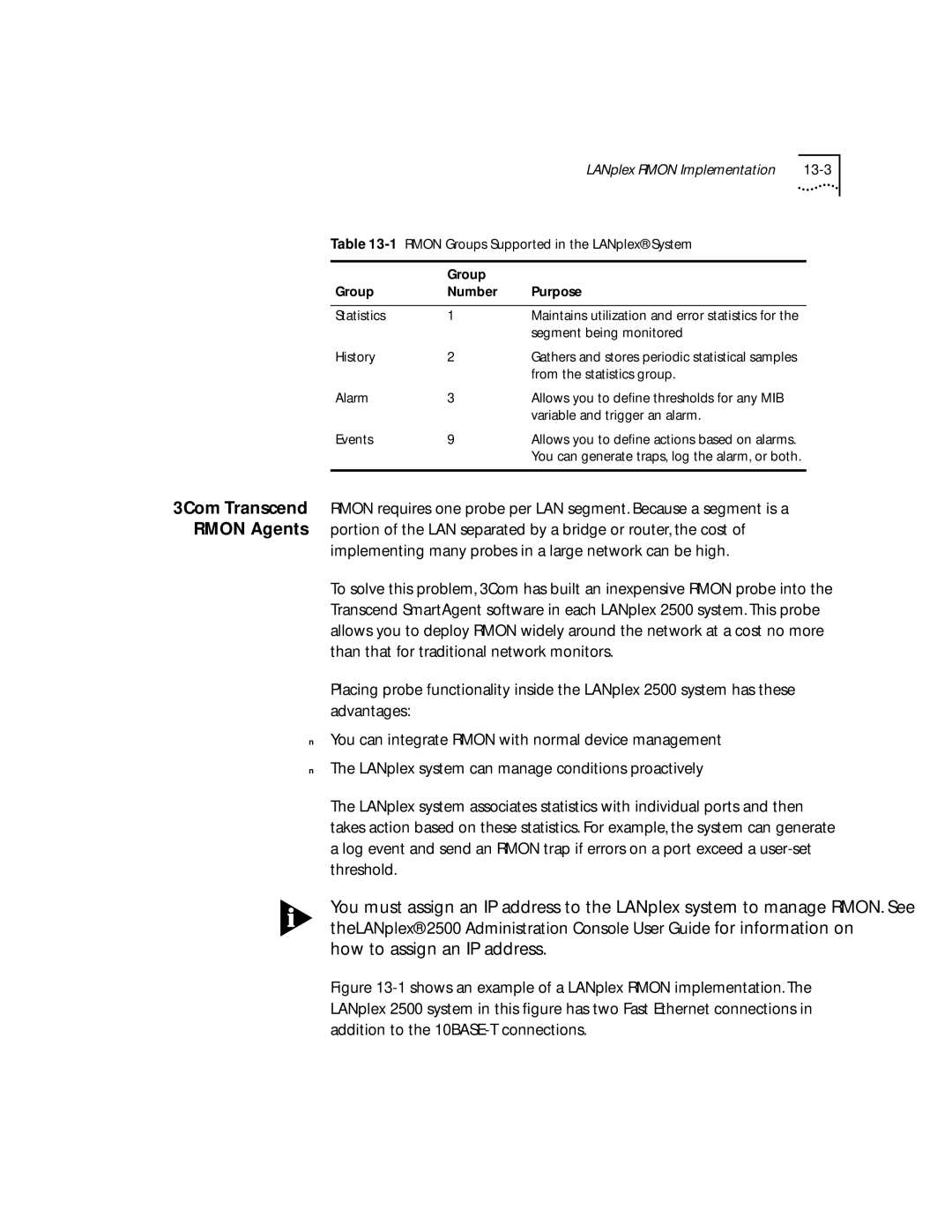Lanplex 2500 Extended Switching User Guide
3Com Corporation 5400 Bayfront Plaza Santa Clara, California
Contents
Overlapped IP VLANs
What Is Routing?
Default Route Address Resolution Protocol ARP
Example
Dvmrp Metric Value
Mbone Multicast Routing Algorithms Flooding
Pruning
Elements IPX Routing
About Aarp
Administering interfaces LIS Interfaces
Administering Routes
Displaying Interfaces
10-2
Defining a Static Route
Displaying the ATM ARP Cache
10-3
11-3
Displaying Routes Displaying the Multicast Cache
11-2
11-3 Modifying an Interface
12-11
What Is RMON?
MIB Objects 13-4 Alarms
12-12
Support from 3Com A-4 Returning Products for Repair A-4
Introduction
When you configure your LANplex 2500 system
About this Guide
Monitoring Rmon
Icon Type Description Information Note
Conventions
List conventions that are used throughout this guide
Instructions
LANplex 2500 Documentation
LANplex 2500 Software Release Notes
801-00322-000
Module Installation Guides
2-5 ,
About this Guide
About LANplex
Features
Switching
Extended
Using Menus
Switching software
Bridge Menu Hierarchy
IP Menu Hierarchy
IPX Menu Hierarchy
Appletalk Menu Hierarchy
About VLANs
For the network administrator
Vlans on
Vlan concept in LAN technology helps minimize broadcast
Vlans on the Lanplex System
Ethertype, Snap PID
SNA Services over Ethernet Ethertype
Vlan Configuration Protocol Suite
DECnet
Switch Ports
Layer 3 Addressing Information
About VLANs
IP port
VLAN, so the Default Vlan is used
Index 1 2 Data received on
Source port
Data received on Is flooded on Because XNS port
So the Default Vlan is used
Default None
System
On port IP subnet
Data received on Is flooded on Because IP subnet
158.103.122.2
158.103.123.2
About VLANs
Vlan Examples Example
Example of a Protocol-Sensitive Vlan Configuration
Example
A Vlan Configuration with Servers on Separate 100BASE-T ports
Vlans on the Lanplex System
Bridging and Routing
Lanplex System
Subnetted Architecture with LANplex Switching Hubs
Multiple Ports per Subnets with the LANplex 2500 System
Bridging
Routing Models
Bridging in the Traditional Bridging and Routing Model
Bridging in the LANplex Bridging and Routing Model
Routing in the LANplex Bridging and Routing Model
Bridging and Routing in the Lanplex System
OSI Model
Routing with IP Technology
IP Routing
Section
Elements of IP
Routing
Hardware-configured 48-bit addresses
Address Classes
How a Subnet Mask Is Applied to the IP Address
Shows the routing table of the router in Figure
Dynamic Routes Using RIP
Static Routes
Example of an ARP Cache
Example of ARP Cache Updated with ARP Reply
Errors
Transmission
Routing with
Classical IP over
References
Forwarding to Nodes within an LIS
Routing with IP Technology
Multicast Routing
Routing with IP Multicast
About IP
Tunnels on page 6 for more information about tunnels
To a multicast router
Provider
Multicast tunnel only if the Time-To-Live TTL value present
Algorithms routing
Flooding Spanning Trees Reverse Path Forwarding
Simple Network Implemented Without Using Spanning Tree
Shows a simple network with five links
Which are described in this section
Multicast
Interfaces
Routing with IP Multicast
Environment
IPX Routing
NetWare
Be provided by protocols above IPX
NetWare Protocols and the OSI Reference Model
Protocol RIP
Shows the IPX packet format
How IPX Routing Works
IPX Packet Routing
How IPX Routing Works
Intranetwork
Service Advertising Protocol SAP
Elements
Aging Timer The time since the network’s last update
Shows an example of a typical routing information table
Internetwork Service Information
IPX Packet Format
Routing with IPX
Server Information Table
Server Information Maintenance
Elements of IPX Routing
Routing with IPX
AppleTalk
Routing in AN Appletalk Environment
About AppleTalk
Network
Named Entities
AppleTalk Networks and AppleTalk Zones
Protocols
AppleTalk Protocols and the OSI Reference Model
Routing in AN Appletalk Environment
AppleTalk Protocols
Network Router Interface
AppleTalk Protocols
Mapping for both extended and nonextended networks
About Aarp
Description language used by many printers
Another probe packet
About Aarp
Routing in AN Appletalk Environment
Displaying Vlan Information
Administering Vlans
From the top level of the Administration Console, enter
Fields for Vlan Information Description Index
Example of a detailed display for the VLANs
Describes these statistics
Layer
Defining Vlan Information
Modifying Vlan Information
Vlan
Enter the indexes for the VLANs you want to remove Example
Information
Removing Vlan Follow these steps to remove a Vlan definition
Administering Vlans
Administering IP Routing
Administering
Administering IP Routing
Ip interface summary Ip interface detail
Defining an IP LIS Interface
Example summary display
Example detail display
LIS interface example with both PVCs and SVCs
Atm Route Arp Detail
Removing an
Accept the default yes if you want to delete the interface
Modifying an Interface
Removing an Advertisement Address
Removing a Permanent Virtual Circuit PVC
Routes
Adding a Permanent Virtual Circuit PVC
Automatically
Timing out
Static Route was statically configured Learned
Interface Status Information Description Direct
Timed out
Displaying Routing Table
Removing a Route
Flushing a Route
Corresponding MAC addresses
Default route is immediately removed from the routing table
ARP Cache
Displaying the ARP
String from the top level of the Administration Console
Example display of the contents of the ARP cache
Cache
Flushing the ARP Cache
Administer the ATM ARP cache
ATM ARP Servers
ARP cache entries are immediately removed from the table
ATM switch, such as 3Com’s CELLplex 7000 system
Removing an ATM ARP Server
Removing an ATM ARP Cache Entry
Ip atmArpServer arp Display
Flushing the ATM
Bootp including Dhcp = Time = DNS =
UDP Helper
Are modified and then forwarded through the router
Displaying UDP Helper Information
Enabling Disabling IP Routing
Mode
Setting the RIP
Enabling Disabling Icmp Router Discovery
Operate in any of three modes
You may receive one of the following responses
Pinging an IP Station
Enter the IP address of the station you want to ping
Displaying IP Statistics
Describes the IP statistics
Administering IP Routing
Administering
IP Multicast Routing
Disabling Igmp
Enabling and Disabling Dvmrp
Enabling
Methods to make this determination
Administering IP
Example multicast interface configuration
From the top level of the Administration Console, enter
Rate Limit
Disabling Multicast Interfaces
Enabling Multicast Interfaces
IP address of the remote multicast router
Multicast Tunnels Administration Console, enter
Multicast Tunnels
Displaying
Tunnel is removed
Defining a To define an IP multicast tunnel Multicast Tunnel
Removing a Multicast Tunnel
Displaying Routes
Describes the fields in the route display
Displaying the Multicast Cache
You are prompted for the multicast source address
Following display shows the multicast cache configuration
Describes the fields in the cache display
Administering IP Multicast Routing
Administering IPX Routing
Formats and two Fddi encapsulation formats. The Ethernet
Define an associated interface
Address. Each address within the network should be unique
Is available for communications Up or unavailable Down
From the Administration Console top-level menu, enter
Defining an IPX
Ipx interface modify
Routers
Administration Console
Known to the router
Segment. a tic is approximately 55 milliseconds
Console top-level menu, enter
As well as the routing table
Defining a Static Route
Ipx route remove
Server table using the Administration Console
Servers
Console top-level menu, enter
Defining a Static Server
Removing a Server To remove a server
From the Administration Console top-level menu, enter
Enter the number of hops to the server. Example
Flushing Servers
Setting IPX
Forwarding
Follow the IPX router implementation guidelines
Setting
Enhanced RIP
Brackets, press Return at the prompt
Setting the SAP
Enter the SAP mode off, passive, or active. To use the value
Displaying
Statistics
Example below
Describers the IPX RIP statistics
SAP Entries Number of servers in the server table
Describes the IPX SAP statistics
SAP Requests
Been received
Describes the IPX forwarding statistics
Ipx statistics forwarding
Errors in network layer header
Hdr Errors
Layer header errors
No Routes
Administering Appletalk Routing
Associated AppleTalk interface
Displaying AppleTalk Interfaces
Defining an Interface
Enter the zone name
Removing an Interface
Appletalk route display
Following example shows a routing table display
12-7
Following example shows an Aarp cache display
Removing an Entry To remove an Aarp cache entry Cache
Displaying the Zone Table
Zone Table by Zones
Enter enable or disable at the prompt
Configuring Forwarding
Configuring Checksum
Enter enable or disable at the checksum generation prompt
Enter enable or disable at the checksum verification prompt
Pinging an AppleTalk Node
Following is an example of DDP summary statistics
Describes the AppleTalk DDP statistics you can view
Describes the Rtmp statistics you can view
Displaying Rtmp Information
An example of summary statistics is shown below
Displaying ZIP Information
Describes the ZIP statistics you can view
Displaying NBP Information
Describes the NBP statistics you can view
Remote Monitoring Rmon and the Lanplex System
Remote Monitoring Rmon Technology
Remote Monitoring Rmon Technology
Remote Monitoring Rmon Technology
Segment being monitored
Alarm
Variable and trigger an alarm
History
Management
Information Base
Example of an Rmon MIB Counter Object
Application for details on setting up alarms
Alarms
Instances of when counters exceed their set threshold
You misleading results
Manually Set Thresholds
Generates an alarm only under the following conditions
Appendix
Appendix a Technical Support
Technical Support
Services
Variety of services. This appendix describes these services
On-line Technical
Access by Digital Modem
Press Return to see the 3ComForum Main menu
Your Network
Maintenance, application training, and support services
Support from
Supplier
Support contracts are available from 3Com
U.S. and Canada, call 800 876-3266 for customer service
3Com
Index
Numerics
See also RIP See also SAP
Mbone
MIB
See also Fddi station statistics
Tunnels IP multicast 5-6

